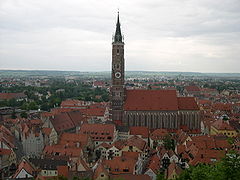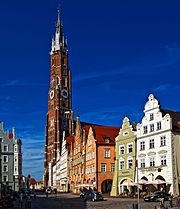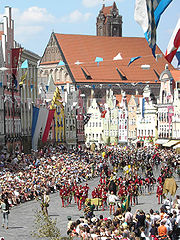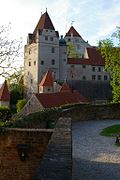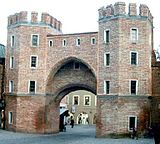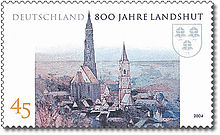- Landshut
-
This article is about the city in Bavaria. For other uses, see Landshut (disambiguation).
Landshut 
Coordinates 48°32′23″N 12°09′3″E / 48.53972°N 12.15083°ECoordinates: 48°32′23″N 12°09′3″E / 48.53972°N 12.15083°E Administration Country Germany State Bavaria Admin. region Lower Bavaria District Urban district Mayor Hans Rampf Basic statistics Area 65.7 km2 (25.4 sq mi) Elevation 445 m (1460 ft) Population 63,258 (31 December 2010)[1] - Density 963 /km2 (2,494 /sq mi) Other information Time zone CET/CEST (UTC+1/+2) Licence plate LA Postal codes 84001-84036 Area code 0871 Website www.landshut.de Landshut (Austro-Bavarian: Landshuad) is a city in Bavaria in the south-east of Germany, belonging to both Eastern and Southern Bavaria. Situated on the banks of the River Isar, Landshut is the capital of Lower Bavaria, one of the seven administrative regions of the Free State of Bavaria. It is also the seat of the surrounding district. With a population of more than 60,000, Landshut is the largest city in Lower Bavaria, followed by Passau and Straubing, as well as Eastern Bavaria's second biggest city after Regensburg.
Owing to its characteristic coat of arms, the city is also often called "Three Helmets City" (German: Dreihelmenstadt).
Due to its proximity and easy access to Munich and the Franz Josef Strauss International Airport, situated halfway between Munich and Landshut on the banks of the Isar, the city has East Bavaria's lowest unemployment rate (ca. 4.2% in October 2006), lower than the Bavarian average of ca. 5.8%.
Contents
Geography
Settings
Landshut lies in the centre of Lower Bavaria, and is part of the Alpine foothills. The River Isar runs through the city centre. Landshut is about 72 kilometres (45 mi) northeast of Munich.
Climate
History
The city of Landshut and Trausnitz castle were founded in 1204 by Duke Louis I. Landshut was already a Wittelsbach residence by 1231, and in 1255, when the duchy of Bavaria was split in two, Landshut also became the capital of Lower Bavaria. Duke Henry XVI was the first of the three famous rich dukes who ruled Bayern-Landshut in the 15th century. The wedding of Duke George with the Polish Princess Royal Jadwiga Jagiellon in 1475 was celebrated in Landshut with one of the most splendid festivals of the Middle Ages (called "Landshuter Hochzeit"). After his death and the Landshut War of Succession, Bavaria-Landshut was reunited with Bavaria-Munich.
Louis X, Duke of Bavaria built the Landshut Residence 1537–1543 after his visit to Italy. Louis built the first Renaissance palace constructed north of the Alps after the Palazzo Te in Mantua. William V, Duke of Bavaria ordered to upgrade Trausnitz Castle from a gothic fortification into a renaissance complex when he lived in Landshut as crown prince for ten years until 1579. Afterwards Landshut lost most of its importance until the University of Ingolstadt was moved to Landshut in 1800. But already in 1826 the university was transferred to Munich.
During World War II, a subcamp of Dachau concentration camp was located in the city to provide slave labour for local industry.
The U.S. Army maintained facilities in Landshut, including Pinder Kaserne and a dependent housing area, until 1965.
Since the opening of Munich airport close to Landshut in 1992 the city has become an attractive business location.
Main sights and culture
The city is of national importance because of its predominantly Gothic architecture within the historic city centre, especially Trausnitz Castle and the Church of Saint Martin featuring the world's tallest brick tower. Among other Gothic architecture are the churches of St. Jodok and Holy Spirit, but also the Town Hall and the Ländtor, the only still existing gate of the medieval fortification.
Landshut is also known for a festival celebrated every four years called the Landshuter Hochzeit, commemorating the 1475 marriage of George of Bavaria and Jadwiga Jagiellon.
The renaissance era produced in particular the decorated inner courtyard of the Trausnitz Castle and the ducal Landshut Residence in the inner city. Baroque churches are represented by the Jesuit church St. Ignatius, the Dominican church St. Blasius and the church of St. Joseph. Also the medieval churches of the Seligenthal Monastery and of the Cistercians were redesigned in baroque style. Many old middle-class houses of the past in the Old Town still represent the history of the city from the Gothic times to the Neo-Classicism.
Theatres
- Stadttheater (city theatre)
- Kleines Theater
- Theater Nikola
Cinemas
Museums
- Skulpturenmuseum im Hofberg (Sculptural Museum in Hofberg)
Venues
- Eisstadion am Gutenbergweg – Indoor Ice hockey arena, mainly used by the Landshut Cannibals
- Sparkassen-Arena – Mainly used for concerts and fairs
- Grieserwiese – Giant parking area located between Wittstraße and the bank of the river Isar used for the annual Frühjahrs- und Bartlmädult
Businesses
- BMW
- Cine Project
- Dräxlmaier Group
- Deutsche Telekom
- ebmpapst
- Endor AG/Fanatec
- Renesas (formerly Hitachi)
- Schott Glass
- T.D.T. Transfer Data Test GmbH
- Josef Urzinger GmbH – Textile Mietdienste
- Vishay
There are also two nuclear power plants located 14 km away from Landshut, Isar I (Inactive) and Isar II (Active until 2022).
Twinnings
 Elgin, United Kingdom, since 1956
Elgin, United Kingdom, since 1956 Compiègne, France, since 1962
Compiègne, France, since 1962 Ried im Innkreis, Austria, since 1974
Ried im Innkreis, Austria, since 1974 Schio, Italy, since 1981
Schio, Italy, since 1981 Sibiu, Romania, since 2002
Sibiu, Romania, since 2002
People
Famous citizens
- Rudy Ratzinger, the sole musician of :wumpscut:.
- Martin Stosch – DSDS Season 4 contestant was born in Landshut.
- Joseph Zoettl, monk and creator of the Ave Maria Grotto in Cullman, Alabama
Honorary citizens
- Hans Futterer
- Hans Leinberger
- Roman Herzog
- Erich Kühnhackl
- Ludwig Andreas Feuerbach
- Spitzlberger
- Hansjörg Mößmer
See also
- Battle of Abensberg occurred April 20, 1809.
- Battle of Landshut occurred April 21, 1809.
- Battle of Eckmühl occurred 21 April–22 April 1809.
- Abensberg
- Eckmühl
References
- ^ "Fortschreibung des Bevölkerungsstandes" (in German). Bayerisches Landesamt für Statistik und Datenverarbeitung. 31 December 2010. https://www.statistikdaten.bayern.de/genesis/online?language=de&sequenz=tabelleErgebnis&selectionname=12411-009r&sachmerkmal=QUASTI&sachschluessel=SQUART04&startjahr=2010&endjahr=2010.
External links
 Chisholm, Hugh, ed (1911). "Landshut". Encyclopædia Britannica (11th ed.). Cambridge University Press.
Chisholm, Hugh, ed (1911). "Landshut". Encyclopædia Britannica (11th ed.). Cambridge University Press.- http://www.landshut.de – Official website
- (German) http://www.fh-landshut.de/
- (German) kleines Theater Landshut
- (German) Theater Nikola
- (German) Stadttheater Landshut (City Theatre)
- (German) EVL bzw. Cannibals traditionsreicher Eishockey Verein
Categories:- Towns in Bavaria
- 1204 establishments
Wikimedia Foundation. 2010.


